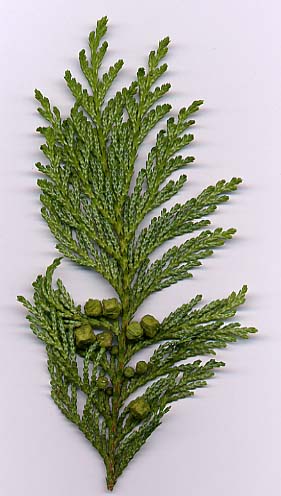
Chamaecyparis, common names cypress or false cypress, is a genus of conifers in the cypress family Cupressaceae, native to eastern Asia and to the western and eastern margins of the United States. The name is derived from the Greek khamai (χαμαί), meaning "on the earth", and kuparissos (κυπάρισσος) for "cypress".
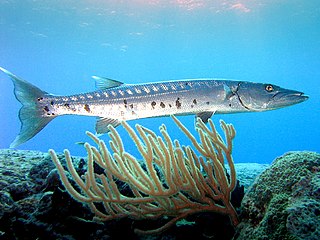
A barracuda is a large, predatory, ray-finned fish known for its fearsome appearance and ferocious behaviour. The barracuda is a saltwater fish of the genus Sphyraena, the only genus in the family Sphyraenidae, which was named by Constantine Samuel Rafinesque in 1815. It is found in tropical and subtropical oceans worldwide ranging from the eastern border of the Atlantic Ocean to the Red Sea, on its western border the Caribbean Sea, and in tropical areas of the Pacific Ocean. Barracudas reside near the top of the water and near coral reefs and sea grasses. Barracudas are targeted by sport-fishing enthusiasts.

Chamaecyparis obtusa is a species of cypress native to central Japan in East Asia, and widely cultivated in the temperate northern hemisphere for its high-quality timber and ornamental qualities, with many cultivars commercially available.
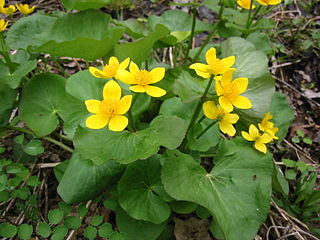
Caltha is a genus of rhizomatous perennial flowering plants in the family Ranunculaceae, to which ten species have been assigned. They occur in moist environments in temperate and cold regions of both the Northern and Southern Hemispheres. Their leaves are generally heart-shaped or kidney-shaped, or are characteristically diplophyllous. Flowers are star shaped and mostly yellow to white. True petals and nectaries are missing but the five or more sepals are distinctly colored. As usual in the buttercup family there is a circle of stamens around free carpels.

Scorpaenopsis is a genus of marine ray-finned fish belonging to the family Scorpaenidae, the scorpionfishes. The fishes in this genus are found in the Indian and Pacific Ocean.

The broad-tailed paradise whydah is a species of bird in the family Viduidae. It is found in woodland and acacia savanna habitat in Sub-Saharan Africa from Angola to Uganda, Tanzania and Mozambique. A brood parasite, it has a wide range and the International Union for Conservation of Nature has assessed it as being of least concern.

Neverita is a genus of medium-sized to large sea snails, marine gastropod molluscs in the subfamily Polinicinae of the family Naticidae, the moon snails
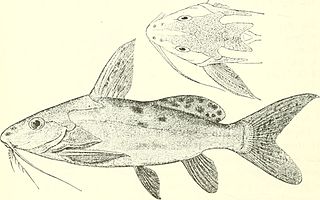
Synodontis haugi, known as the black synodontis, is a species of upside-down catfish native to Gabon where it is found in the Ogowe River basin. It was first collected by M.E. Haug and described by French zoologist Jacques Pellegrin in 1906, based upon a holotype discovered in the Ogooué River, near Ngomo, Gabon. The specific name "huagi" is a tribute to the original collector of the species.

Synodontis pardalis is a species of upside-down catfish that is endemic to Cameroon where it occurs in the Dja River drainage. It was first described by British-Belgian zoologist George Albert Boulenger in 1908, from specimens collected in the Dja River in southern Cameroon. The species name pardalis is derived from the Greek word pardalis, which means "leopard", which refers to the spotted pattern on the fish.

An anchovy is a small, common forage fish of the family Engraulidae. Most species are found in marine waters, but several will enter brackish water, and some in South America are restricted to fresh water.

Myrceugenia obtusa, also known as raran, is an evergreen tree endemic to Chile from Coquimbo to Cautin. It grows mainly in the coastal mountains on moist sites.
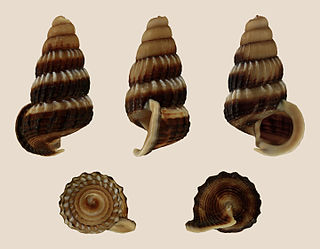
Cerithidea obtusa is a species of sea snail, a marine gastropod mollusk in the family Potamididae. The Obtuse Horn Shell, also known as Mud Creeper, is a relatively common snail found in muddy coastal areas. It grows to around 5–6 cm. It is used as a food in Southeast Asia, where it is known by the name of Belitung and Siput Sedut in Malay, Hoi Joob Jaeng, and Ốc Len in Vietnamese.

Engellaria obtusa is a species of flowering plant in the family Caryophyllaceae known by the common names Rocky Mountain chickweed, blunt-sepaled starwort, and obtuse starwort. It is the sole species in genus Engellaria. It is native to western North America, from British Columbia and Alberta to California to Colorado, where it grows in moist areas in forests and on mountain slopes.
Hopia obtusa is a species of grass commonly known as vine mesquite. This plant was treated as Panicum obtusum until recently when more molecular and genetic material revealed new information about it. Hopia obtusa is now placed in the monotypic genus Hopia.

Azenia obtusa, the obtuse yellow moth, is a moth of the family Noctuidae. The species was first described by Gottlieb August Wilhelm Herrich-Schäffer in 1854. It is found in North America from southern Ontario and New York to Florida and west to Texas and Missouri.

Laurencia is a genus of red algae that grow in temperate and tropical shore areas, in littoral to sublittoral habitats, at depths up to 65 m (213 ft).

Calectasia obtusa, commonly known as a blue tinsel lily or blunt-leaved tinsel lily is a plant in the family Dasypogonaceae growing as an erect, small shrub with stems to 50 cm. It is endemic to the south-west of Western Australia, widespread in most of its range but only known from nine populations.

Caltha obtusa; commonly known as white caltha; is a small, perennial herbaceous plant belonging to the family Ranunculaceae, that grows in open vegetations in mountainous areas, and is endemic to New Zealand's South Island.

Iselica is a genus of small sea snails, marine heterobranch gastropod molluscs or micromolluscs in the family Amathinidae.

Scorpaenopsis obtusa, the shortsnout scorpionfish, is a species of venomous marine ray-finned fish belonging to the family Scorpaenidae, the scorpionfishes. This species is found in the Indo-West Pacific Ocean all the way from Western Australia to Papua New Guinea and then north to Japan.


















